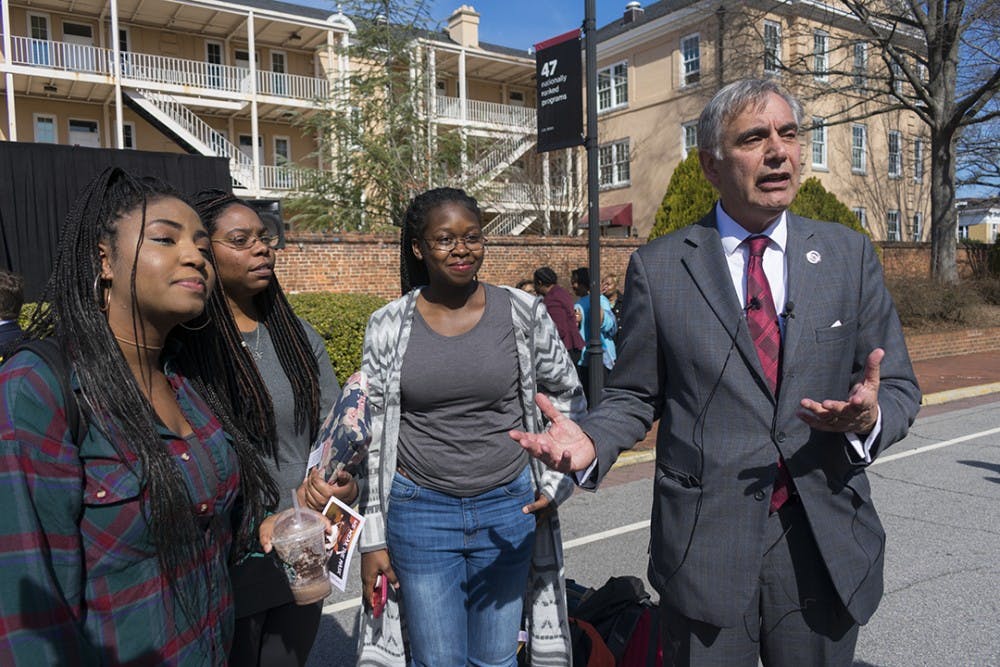Racially-charged posters on Martin Luther King Jr. Day. A suicide in a campus building. Discriminatory social media posts. When situations happen on campus that require a response from the university administration, students' reactions range from appreciative to highly critical.
To explore university policy on campus crises, The Daily Gamecock sat down with USC's Chief Officer of Communication Wes Hickman. He discussed the management of recent crises and the specific role of the administration in contrast to that of other university officials. The following interview has been edited for clarity and brevity.

Q: What does the university do when a situation, like this (i.e the racially charged posters and suicide in Gambrell) arises?
A: There’s a lot of different kinds of crises. All the senior administrators go through crisis training. Our USC police department ... is the number one convening group around crisis management. They implement a system called the Incident Command System. It’s a federally recognized system chain of command that dictates how you’re going to operate in an emergency situation.
That system works in two phases. There’s what’s called the executive policy group and that’s all the senior administrators at the university. Then there’s an emergency management team, and those are the associate vice presidents, directors and people like that who work at that level. So we all train and do workshops in that type of thing all the time so that we’re always up on the latest in incident command systems, crisis management, crisis communication and all that sort of stuff. You take the lessons you learn from that and apply them in individual situations because every situation is different.
As an institution we have to make sure we have the facts right. One of the things that I tell people is when you’re going into an incident response, as a professional your responsibility is to take a breath, understand the situation and start to understand the facts at hand. You see police departments do this a lot when they’re conducting an investigation. The other thing is that a situation like with the flyers is a great opportunity for an institution to fall back to your values ... We know that our values are based on the principles espoused in the Carolinian Creed — civility and respect for all. The flyer situation clearly runs against the values of our institution. What you want to do is make sure you’re communicating those values throughout that institution and throughout that incident. The best time to build trust among your audiences and your community members is not during a crisis. It’s every other day of the year. If we are doing our best to live the Carolinian Creed as an institution, as individuals ... that’s the best way to combat those types of things.
Q: What separates the roles of the administration and student life coordinators in times of crisis?
A: Our job is really to look at the strategy and the response to a scenario. The people who are responsible for carrying that out are really there to make sure that those things get done in a very professional way. For example, the vice president of student affairs is probably not going to be, well certainly not going to be, on the front lines as a counselor, but we’re going to rely on our trained professional staff to do that. We have taken great care then to hire the professional staff that we need in each area ... to make sure we can respond to things like that. If you take the death by suicide in Gambrell and the death by suicide of the student who lived in Capstone, those are two examples especially of where we have to mobilize a pretty extensive counseling effort and inform students of what’s going on. In those situations in particular ... those are very delicate situations ... the coroner generally doesn’t release the cause of death, and there are a lot of reasons behind that psychologically, sociologically ... you don’t want to create what’s called a contagion factor among students. So there’s a responsibility of the university to talk about it in a very professional and respectful kind of way, there’s a responsibility of the media to talk about it in a very professional and respectful way, and at the same time we have to meet the needs of our students.
Q: There was some backlash against the administration (following the first #NotOnOurCampus event) can you speak to that?
A: Part of the challenge with the event the day after was that it was planned for a day the president was not in town. There again you have to balance the need for convening everybody to have a conversation with the availability of people who can be there. What I think is often missed is the fact that the university, with the president’s blessing, put out a statement immediately in response. The president and our board chairman put out a joint statement the very next day when we had a little bit more information and some more facts ... the idea that it’s being swept under the rug is not true. It’s actually being dealt with. There was a significant investigation by USC PD ... sometimes when you’re conducting an investigation it hampers the investigation to put information into the public arena. You have to balance between keeping your public informed and doing the things that are best for the investigation.

